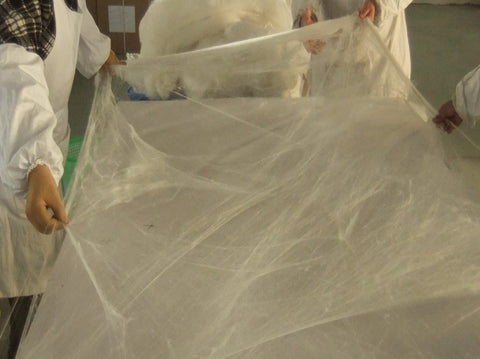Silkworm and silk cocoon
The climate in eastern China is warm and sunny. Traditionally, silk cultivation is an important industry in this region. Every year in March the mulberry trees grow leaves. In May, the eggs of silkworms are laid, which after hatching feed on the leaves of the mulberry tree.
The life cycle of the silkworm is approximately 30 days. The silkworm then spins a fine, long thread from which it builds its cocoon. As a rule, each caterpillar forms its own cocoon, but it often happens that two or even three caterpillars cocoon themselves in a common cocoon. The silk threads from the "normal" cocoons (with only one caterpillar) can be uncoiled and finally processed into silk fabric. Cocoons with two or three caterpillars cannot be uncoiled because the silk fibers are confused. They are used for filling the silk blanket.

(mulberry leaves)

(silkworms)

(silkworm farming)
Extraction of silk fibers
Obtaining the long silk fibers from the cocoons is a very complicated process and requires many years of experience and craftsmanship.
First, the silk cocoons are soaked in water and boiled to loosen the fibers. The cocoons are then brushed and pulled into a silk fleece.
The dried silk fleece is natural white and has a beautiful shine. It is the basis for the filling of the silk duvet.

(silk cocoons)

(Dried silk fleece)
Pulling and folding the silk fleece
The silk fleece is pulled evenly in all four directions like a net to the size of the future blanket. This requires many years of experience and a lot of strength. Depending on the desired weight of the blanket, the silk net is placed criss-cross in several layers.
The silk fiber filling is surrounded by a cover and sewn onto the edge so that the filling does not slip in the cover. This is enough to stabilize the filling.
Orignee silk blankets are given a beautiful circular quilting purely for visual reasons (and so that customers have the feeling that nothing can actually slip).

(Pulling and folding the silk fleece)

(Control of sewing processing)


